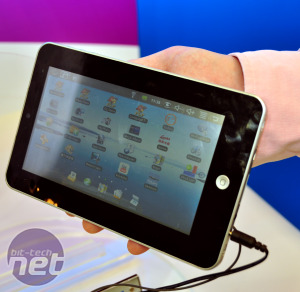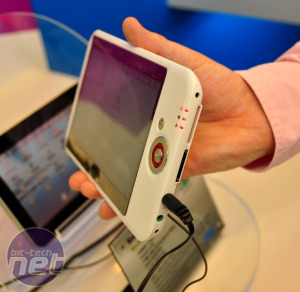What happened to VIA? Tablets, platforms and x86 v ARM
August 10, 2010 | 08:40

Tablet choice
BT: So how is VIA’s 7in tablet coming along?VIA: Well we have quite a few customers in China already, and the biggest retail chain there has recently already stocked a 999RMB tablet and seen it shooting off the shelves. Also we’re seeing a lot of interest such as India, South America and even Western Europe, so I think the sub $200 market is where the growth will be for us.
Think of it as a feature-phone upgrade, rather than PC. People are looking for bigger screens for mobile web browsing, and with the rise of app stores rather than traditional applications we see tablets change the way people have information delivered to them. Once the developers commit to the platform, and once localisation of applications becomes more popular, people start using it more so the value of the whole platform increases as well.
If we think how far the PC has come over the last 20 years – it used to never do graphics, never talk to other computers and the infrastructure has changed for it to do more. The same is happening on the mobile and tablet space now as 3G gets more ubiquitous.
Tablets even have variety and choice between 720p or 1080p video, SD card slots, USB sockets etc which are a necessary PC like flexibility beyond the iPad. There’s also choice of screens – I actually prefer 7in to the 10in models, because it’s easier to carry and lighter. We’ll see companies offering designs with 5, 7, 9, 10 inch screens.
Currently 7 inch is still the cheapest, at 800x480 – which is an Android limitation. Android 3.0 will broaden its scope to allow larger resolutions. I think this year the market is very much in an experimental stage – it’s very much like when I came to Taiwan 20 years ago and looked at the motherboard business. A lot of companies entered it; some innovation was required and aggressive players came through after looking closely how to do it.
The thing about the iPad – everyone underestimated the volume the iPad would ship and I think the same is happening on Android - people don't understand the dynamics yet.
BT: Is that more of a marketing thing though? Apple and Google have a solid brand.
VIA: Yep. If you think the thing with the iPad is that when it was announced no industry analyst went out and said “this will be huge”, then Apple suddenly ship one million and sudden;y everyone goes “OK then!" Then there's two [million], and we have people claiming that this year it might be 10 million units. Now the Android tablet market is more difficult to understand because there are a lot more different players and a lot of them are not particularly visible in the West. CrunchGear ran an article last week about "Where are all the Android tablets?" – Well the answer is they are all being sold in China and similar markets. It’s very hard to track what’s happening out there.
If you look at the mobile phone market - the white box market - when MediaTek tried to do that nobody really noticed – certainly in the West – until Apple couldn’t sell many iPhones in China, then everyone looked at why and noticed there were hundreds of millions of these other phones being sold under everyone’s radar, and I think the same thing is happening/will happen with tablets, but it'll be slightly more visible now.
BT: Is that a software localisation thing? A cultural difference?
VIA: It’s more question of [the distribution and sales] channel. One very interesting theory in the technology industry is that before it used to be that America defined the 'tech market'. And it used to be that if you talked to any Taiwan company - motherboard maker - it was only for the US market. Now what are companies designing for? There are specific designs for the Chinese market and its consumers.
Chinese consumers are setting the standard - like the mobile phone market. The Chinese consumer wanted a low cost smartphone which the big brands were not able or unwilling to provide, so suddenly other companies step in; now MediaTek and other companies are talking about the $100 smartphone.

MSI MPG Velox 100R Chassis Review
October 14 2021 | 15:04










Want to comment? Please log in.